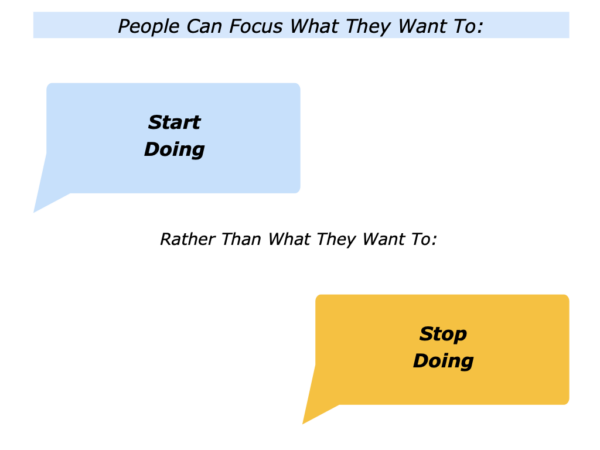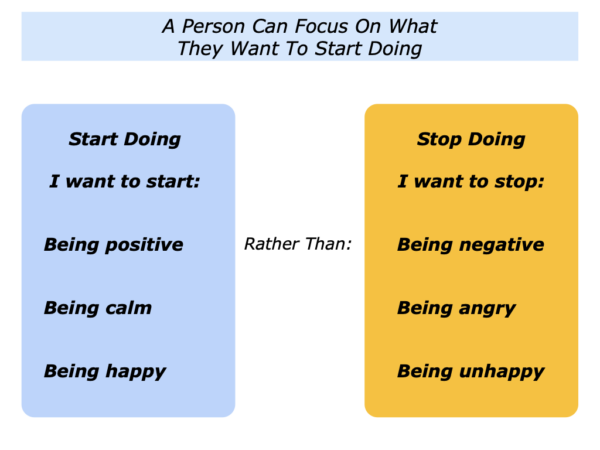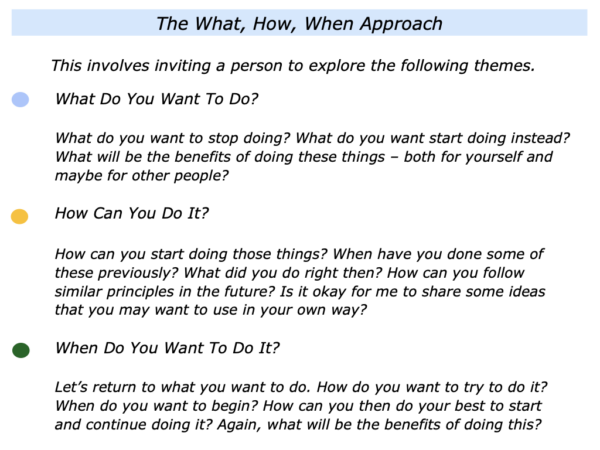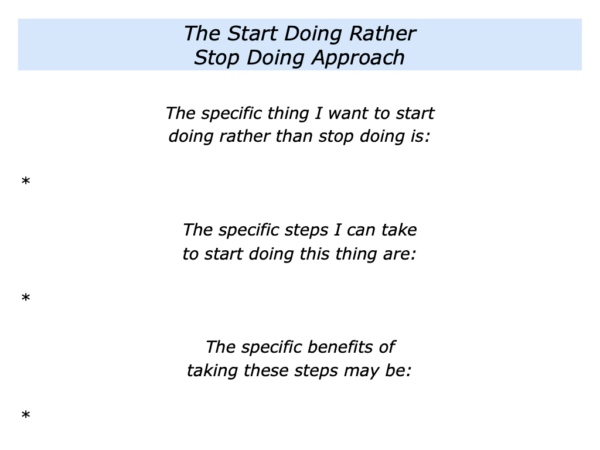
People sometimes talk about what they want to stop doing in their lives or work. A person may focus on negative things, for example, and say something along the following lines.
I want to stop:
Feeling stressed … Feeling depressed … Feeling angry.
This is a scenario I sometimes encountered when doing therapy sessions. A person would describe what they wanted to stop doing or stop feeling. At a certain point, I would ask them:
“What do you want to start doing instead?”
There are several reasons for taking this approach. The main reason is that it can be more positive and more effective for a person:
To start focusing on a positive goal rather than to stop focusing on a negative goal.
Such an approach is more uplifting and practical. This is because: a) it is possible to achieve a positive goal; b) it is not possible to ever be sure you have achieved a negative goal.
This approach also involves following the old rule that: ‘what we focus on, we become.’ If we focus on what we want to start doing, we are more likely to be positive. If we focus on something we want to stop doing, we are giving it more power over us.
Let’s look at some examples of where a person can focus on what they want to start doing and work towards a positive goal. These can include the following.

There are many ways to help a person to take these steps. Let’s look at one approach. This involves using the What, How, When approach. It invites a person to focus on the following themes.
First: What they want to do. Second: How they can do it. This part including recalling times when they have done something similar successfully in the past. Third: When they want to do it.
If appropriate, you can also ask if it is okay for you to share some ideas that may help. They can then take the ideas they like and use them in their own way. Here is a summary of the themes to explore.

The following section gives an example of one way this approach can be translated into action. There are, of course, many other ways to help a person to focus on what they want to start doing rather than stop doing.
Laura – Wanting To
Feel More In Control
Laura was a person who wanted to feel more in control of her life. She explained this in the following way.
“I want to stop feeling so stressed and also stop having panic attacks. I am going through a phase that is unusual for me.
“I am normally organised person and pride myself in being able to deal with problems. That is what I do in my work, where I manage the accounts of several difficult customers.
“My father died recently, however, and since then I have been having panic attacks. I have been to the doctor who ran some tests. He says there is no medical reason for the attacks.
“My father and I were close and his death was unexpected. Since then I have taken care of everything – the funeral, my mother, relatives, solicitors, everything. This is normally the case in the family and at work.
“But now I don’t take care of myself. Suddenly I get panic attacks in the street or at work and it is embarrassing.
“It will take time to come to terms with my father’s death. But I just need to find a way to deal with the panic attacks and get on with my life.”
Laura recognised that she may not be able to control her mood swings because these were part of grieving. Trying to fight the feelings did not work, so we focused on what she wanted to start doing.
She wanted to start being calmer and stop having panic attacks.
How to take these steps? We began by exploring if she knew when the attacks were going to happen. What were the warning signs? Laura described the following sequence.
She felt tired through lack of sleep, often after spending hours counselling other people in their extended family;
She felt a tingling sensation in her hands, which then crept up her body;
She felt detached and began to feel dizzy;
She had difficulty breathing and started to sweat;
She wanted to escape from the situation and, if possible, find a place to be quiet;
She managed to recover after 10 minutes and was able to resume whatever she had been doing before the attack.
Looking at this sequence, Laura saw that they could intervene at the first warning sign, the tingling sensation in her hands. She could probably do something to start a positive sequence which had more healthy effects, rather than fall into the negative sequence.
The question was: “How?” Looking back on her life, we explored when she had managed to stay calm in a challenging situation? Laura gave the following answer.
“I used to compete as a high jumper. During the events I used to put on my headphones and play soothing music. This also helped me to breathe more deeply.
“Putting on the music, I went into my own world, even if only for a few minutes. This worked. It helped me to deal with any nerves and do my best.”
How could she follow similar strategies in her daily life? Laura could certainly put on her earphones and play music when travelling to work on the tube. This would help her to feel calmer, but it would be more difficult at work. Laura began to explore this theme.
“Breathing is probably the key. I can contact my old sports coach. He knows several people who help athletes to perform under pressure. Failing that, I will revisit my old breathing techniques.”
We explored strategies she could use to manage her feelings when experiencing difficulties at work. These included practical things she could do:
To buy time to collect her thoughts;
To clarify the results she wanted to achieve and rehearse what she was going to do in the situation;
To follow her chosen strategy and do her best to achieve the desired results.
Looking ahead, we rehearsed how she could follow these steps in specific situations. These included during meetings and when thrown a curve ball by her boss. She began building her repertoire for buying time, reflecting and then doing her best to get the desired results.
Laura also planned to take more care of her physical and psychological health. This called for getting more sleep, eating properly and returning to daily exercise. She aimed to spend more time with her encouragers rather than only counsel other people.
Two months later she reported that, whilst experiencing some mood swings, she felt more able to manage her feelings. It would take time, but Laura felt more in control of being able to shape her future life.
There are many ways to manage emotions. One approach is for a person to focus on what they want to start doing rather than stop doing. They can then take practical steps to achieve their aims.
Can you think of a situation where you may want to follow elements of this approach? What do you want to start doing in that situation? What are the steps you can take? What may be the benefits – both for yourself and other people?
If you wish, try tackling the exercise on this theme. This invites you to complete the following sentences.







Leave a Reply